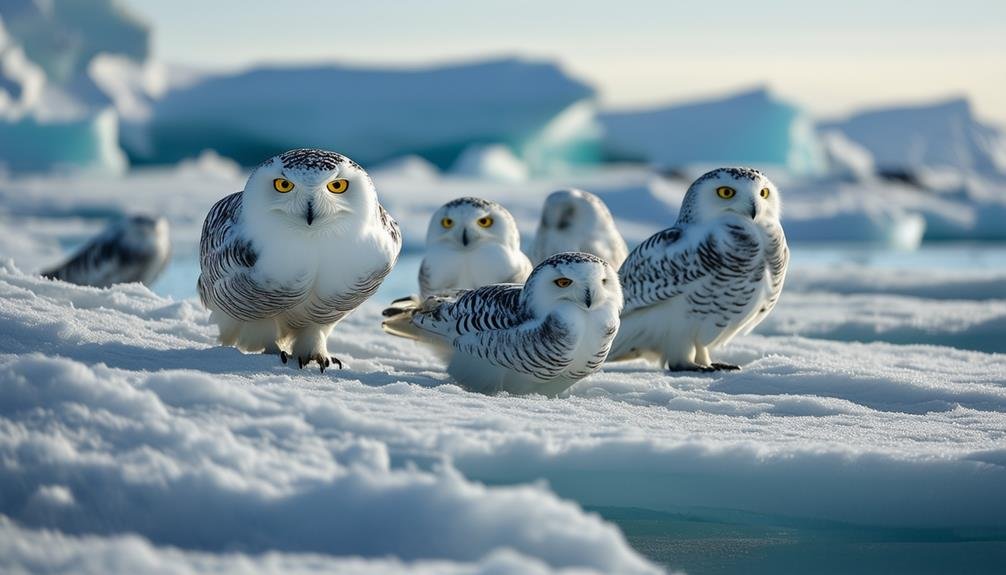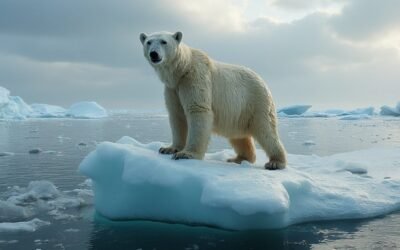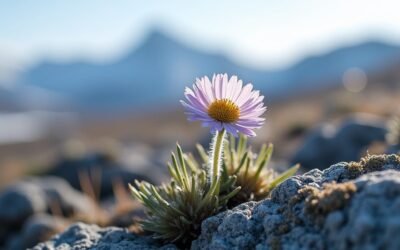Arctic bird species face extinction risks primarily due to climate change, habitat loss, pollution, human activity, and food source disruptions. As temperatures rise, prey populations shift, limiting food availability and affecting breeding success. You'll find that habitats are shrinking due to both climatic changes and human encroachment, pushing birds into increasingly smaller areas. Additionally, pollution from chemicals like DDT and PCBs compromises their health and reproductive capabilities. Human activities, including industrial development and oil spills, further degrade their living conditions. Recognizing these interconnected challenges emphasizes the urgent need for conservation efforts to guarantee their survival. There's more to uncover on how these factors interplay.
Main Points
- Climate change alters habitats and prey availability, increasing extinction risks for Arctic birds.
- Habitat loss from human encroachment and industrial development reduces breeding grounds.
- Pollution, including legacy chemicals like DDT and PCBs, impairs bird health and reproduction.
- Human activities, such as oil spills and noise pollution, directly harm bird populations.
- Disruptions in food sources due to environmental changes negatively impact bird survival and reproduction.
Climate Change Impacts
Climate change is reshaping the Arctic, endangering the survival of its native bird species. You're witnessing a scenario where rising temperatures shift prey populations, important for the sustenance of Arctic bird species. These changes in prey availability are directly impacting birds, increasing their extinction risks as the balance of their fragile ecosystem gets disrupted.
Moreover, warmer climates and altered snow conditions are severely affecting the breeding success of these birds. The timing of snowmelt, critical for nesting, is becoming unpredictable. This exploration between breeding periods and food availability means fewer chicks survive to adulthood. You're seeing a direct link between climate change and the dwindling numbers of these unique species.
Additionally, irregular heavy rain events are causing more than just inconvenience. For vulnerable Arctic bird species, these rains mean exposure to hypothermia, greatly raising mortality rates. Each soaked feather spells potential disaster, pushing these birds closer to extinction.
As you investigate further, you'll understand that these aren't isolated incidents but interconnected consequences of climate change. The survival of Arctic bird species hangs in a delicate balance, influenced heavily by the relentless pace of global warming.
Habitat Loss Challenges
Arctic bird species are facing severe habitat loss as shrinking sea ice and human activities encroach on their breeding grounds. Climate change is accelerating the melt of sea ice, essential for the nesting and feeding of these birds. Additionally, industrial development is fragmenting what remains of their natural habitats, pushing them closer to extinction risks.
You might wonder how serious this situation is. Here are three key points that highlight the challenges these birds are facing:
- Shrinking Habitats: As the ice recedes, the available space for Arctic bird species to nest and feed diminishes, forcing them into smaller areas that can support fewer birds.
- Loss of Breeding Grounds: Many species depend on specific Arctic habitats like tundra and coastal areas for breeding. These are being lost at an alarming rate, not just to climate change but also to human encroachment such as mining and oil drilling.
- Disrupted Ecological Balance: The loss of these habitats disrupts the entire ecosystem, making it harder for Arctic bird species to find food and shelter, thereby increasing their vulnerability to other threats and moving them closer to extinction.
Understanding these factors is essential in addressing the habitat loss challenges and mitigating the extinction risks faced by Arctic bird species.
Pollution Effects
Pollutants like DDT and PCBs often linger in the environment, greatly impacting the health and reproductive capabilities of bird species in the Arctic. These chemical threats, persisting in Arctic environments, not only disrupt the lives of birds but also signal broader ecological challenges. As you explore further into the impact of these pollutants, you'll understand that birds act as important indicators of environmental health.
The presence of legacy pollutants such as DDT continues to haunt Arctic bird populations, despite bans and regulations. These chemicals accumulate in the food chain, leading to endocrine disruptions that can affect both wildlife and human health. It's a grim reminder that the effects of pollution extend beyond immediate ecological damage.
Conservation efforts are crucial in mitigating these impacts. By studying how pollution affects Arctic birds, scientists and conservationists can develop strategies to cleanse these pristine environments of long-lasting pollutants. These efforts aren't just about protecting bird species but also about ensuring the health of the entire ecosystem.
As you consider the fragility of Arctic bird populations, it's clear that addressing pollution isn't just a matter of wildlife conservation but also of safeguarding human health and maintaining the balance of delicate Arctic ecosystems.
Human Activity Threats
While pollution continues to pose significant risks, the direct impact of human industrial activities also threatens the survival of Arctic bird species. You might be surprised at the variety of ways in which these activities are pushing several bird species towards extinction. Here are three major threats that human activity poses to these fragile ecosystems:
- Habitat Destruction: The expansion of industrial development, including road and structure building, directly destroys the natural habitats of Arctic birds. This alteration not only displaces birds but also degrades the quality of their remaining environments, making survival increasingly difficult.
- Oil Spills: Industrial activities, particularly those related to oil extraction, have led to numerous oil spills in Arctic regions. These spills are catastrophic for bird populations, coating their feathers, impairing their ability to regulate temperature and float, and poisoning their food sources.
- Noise Pollution: The constant noise from drilling operations disrupts the essential navigation and communication abilities of bird species. This noise can disorient birds, hinder their mating calls, and impact their ability to locate each other and their chicks.
Each of these factors contributes significantly to the challenges faced by Arctic birds, heightening their risk of extinction due to human activity.
Food Source Disruptions

You mightn't realize it, but disruptions in food sources greatly impact the survival of Arctic bird species. As prey populations decline, these birds face increasing challenges. Climate change is a primary driver, altering prey availability and leading to food scarcity. For instance, key prey items specific to the dietary needs of Arctic birds are experiencing shifts in distribution and reductions in numbers. This scarcity not only threatens their day-to-day survival but also their reproductive success.
Such environmental changes are compounding the stress on these birds, already vulnerable due to other factors. As their traditional food sources become less accessible, Arctic bird species must adapt quickly or face severe consequences. The impact of these disruptions extends beyond immediate hunger. It influences reproductive rates and the ability of populations to sustain themselves over time.
Understanding these dynamics is vital. The survival of Arctic bird species hinges on a delicate balance within their ecosystem. As you consider the broader implications of environmental changes, remember that food source availability is an essential aspect of their life cycle, deeply intertwined with the overall health of Arctic environments.
Conservation Efforts
Given the challenges outlined, strong conservation efforts are essential to guarantee the survival of Arctic bird species. You're part of a global team, and here's how you can help:
- Habitat Protection and Restoration: Initiatives to safeguard the unique environments where these birds thrive are paramount. You can support organizations that work to protect and restore these critical areas from the adverse effects of human activity and climate change impacts.
- Community and Research Collaboration: It's important to engage with local communities and support research aimed at understanding the needs of vulnerable populations of Arctic bird species. This collaboration helps tailor conservation actions that are culturally sensitive and ecologically effective.
- Policy Advocacy and Education: By raising awareness and advocating for policies that favor environmental protection, you can influence change. Educational programs that highlight the plight of these birds and the broader environmental challenges can mobilize public support for crucial legislative changes.
These conservation efforts are interconnected, reinforcing each other to build a resilient framework for the survival of Arctic bird species. Your involvement and advocacy play a pivotal role in this mission. Together, we can tackle these challenges and ensure a future where Arctic birds continue to soar.
Frequently Asked Questions
Are Bird Species at Risk of Extinction?
Yes, bird species are indeed at risk of extinction. Habitat destruction, invasive species, pollution impacts, illegal hunting, and inadequate conservation strategies all contribute to their decline.
You'll find that these threats disrupt their natural environments and breeding grounds, making survival increasingly challenging.
It's important to enhance conservation efforts and implement sustainable practices to mitigate these risks and protect the diverse species that play essential roles in ecological balance.
How Are Arctic Birds Affected by Climate Change?
As you navigate the chilling truths of climate change, it's clear that Arctic birds are in a fluster. Their migration patterns are disrupted, and breeding is compromised due to altered prey availability and habitat fragmentation.
Extreme weather events further ruffle their feathers, making survival tougher. This cascade of environmental shifts threatens their existence, painting a stark picture of the challenges these feathered denizens face in their icy homes above the world.
Why Do Birds Become Endangered?
Birds become endangered primarily due to habitat destruction, which includes deforestation and urban expansion.
You're also seeing the effects of illegal poaching and the introduction of invasive species that disrupt established ecosystems.
Additionally, widespread pesticide use can poison the food sources birds rely on, and limited food availability due to environmental changes further threatens their survival.
These factors combined create a perilous situation for bird populations worldwide.
Why Is the Arctic in Danger?
The Arctic is a melting pot of environmental issues, literally. Ice melting accelerates as the climate warms, disrupting habitats. Industrial pollution, along with permafrost thawing, releases harmful substances, further degrading this fragile ecosystem.
Increased shipping routes open paths for invasive species, compounding the threats. These combined factors create a precarious situation for the Arctic, demanding urgent attention to mitigate irreversible damage and preserve its unique biodiversity.
What Are the Main Threats to Arctic Bird Species, and How Can We Protect Them?
Arctic bird species face major threats from climate change, habitat degradation, and human activities such as oil drilling. Rising temperatures disrupt breeding and feeding patterns. To protect arctic bird species, it’s crucial to limit industrial impacts, control pollution, and implement conservation policies to maintain their fragile ecosystems.
Conclusion
As you've seen, Arctic bird species are teetering on the brink of extinction, primarily due to climate change, habitat loss, pollution, human activities, and disrupted food sources. While these challenges are formidable, ongoing conservation efforts offer a glimmer of hope.
By understanding the issues and supporting these initiatives, you can help turn the tide for these birds. Remember, every species preserved is a thread maintained in the intricate tapestry of our ecosystem. Your action counts.


